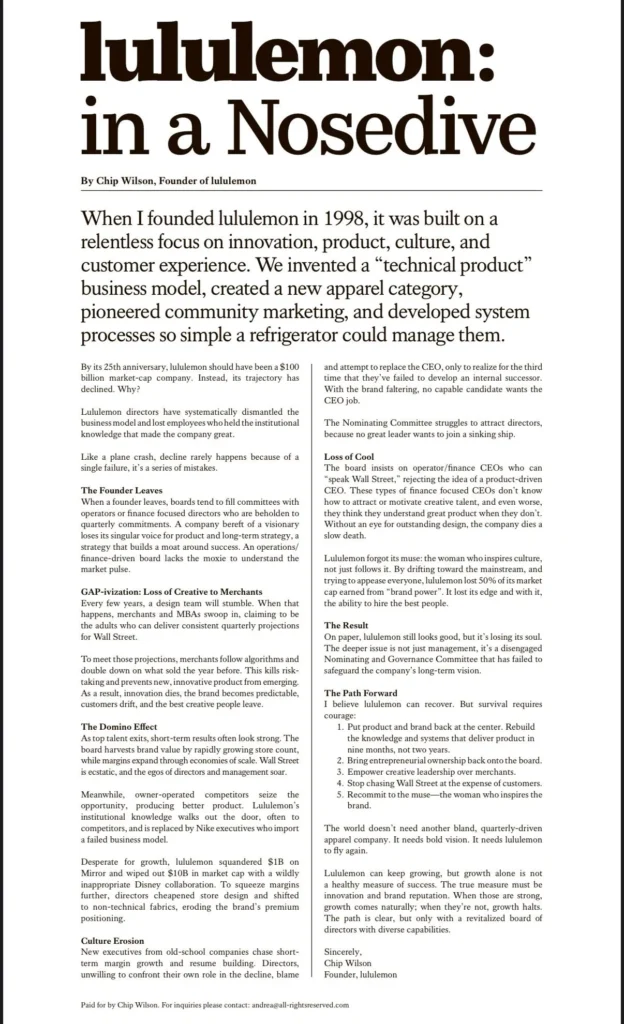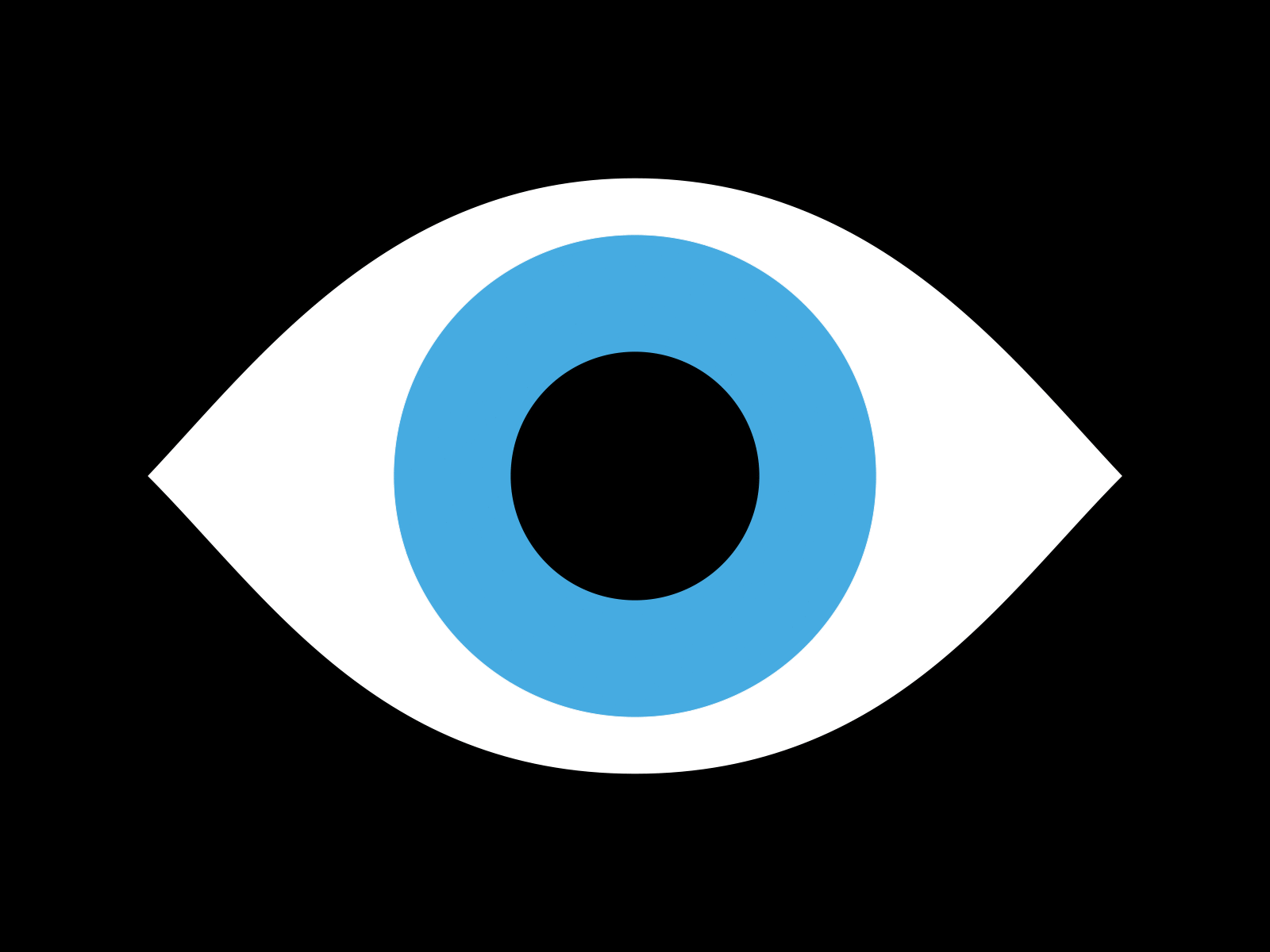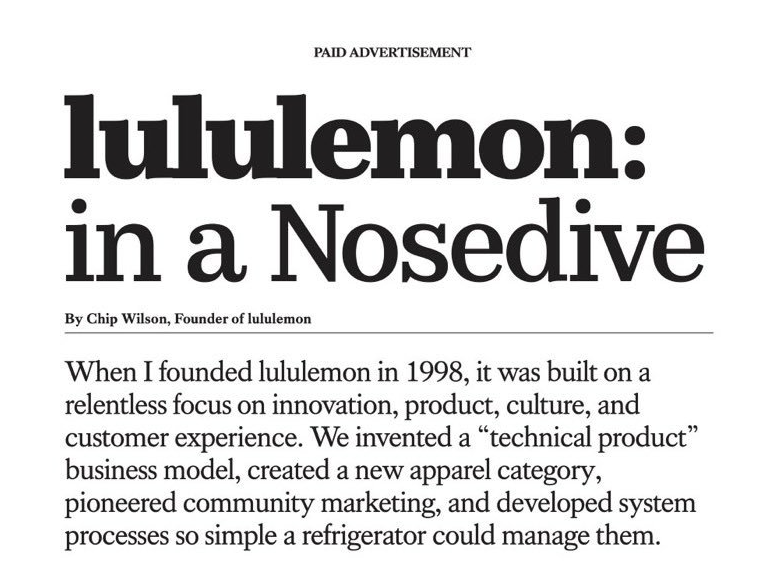The Delusion Everyone Shares
Tasha Eurich’s research team discovered something unsettling: 95% of people believe they’re self-aware. Only 10-15% actually are.
This isn’t about people being stupid. It’s about the gap between what we think we know about ourselves and what’s actually true. Most of us walk around convinced we understand who we are, what we’re good at, and what we stand for. We’re wrong.
But here’s what gets interesting: businesses are just people at scale. They’re collective minds, hive organisms that make decisions, develop personalities, and build identities. And if 85% of individuals can’t see themselves clearly, what are the odds organizations can?
On October 7, 2025, Chip Wilson, founder of Lululemon, took out a full-page ad in The Wall Street Journal. The headline: “lululemon: in a Nosedive.”
His company’s stock had fallen 53% from its peak. He watched the brand he built on crystal-clear identity clarity lose itself completely. And he couldn’t stay quiet.
Wilson’s story is the perfect case study for what happens when self-awareness breaks down at both the individual and organizational levels. Wilson had extraordinary organizational clarity that built a billion-dollar empire, yet personal blind spots destroyed his ability to lead it.

The Superman Who Knew Exactly Who He Was (Organizationally)
In 1998, Wilson created something most entrepreneurs never achieve: perfect clarity about organizational identity. He didn’t start with market research. He started with “Ocean,” a fictional 32-year-old woman born September 28th who never aged. Professional, athletic, educated, financially independent, travelling for business and pleasure. Owned her own condo. Had a cat. Valued quality over quantity.
Ocean wasn’t market segmentation. She was an identity definition.
Wilson refused to serve anyone else. While competitors chased everyone, Wilson built everything (product design, fabric innovation, store experience, pricing, community) for Ocean. When people asked him to expand, he said no. When they suggested he was being too narrow, he doubled down.
This is what true organizational self-awareness looks like. Wilson existed in that rare 10-15% who actually knew who they were. Not who they wanted to be, not who they should be. Who they actually were.
He understood Lululemon’s values: “creatively creative,” which involves creating time to be creative by understanding how to choose freely. Not corporate mission statements — lived philosophy. He’d gone through Landmark Forum and made employees go through it, too. Controversial? Sure. But clear.
He understood Lululemon’s strengths: technical fabric innovation, premium brand, and community building. The company pioneered the entire athleisure category because Wilson saw a gap nobody else saw.
He understood Lululemon’s constraints: they would never be a mass-market brand. They would never chase trends. They would never compromise on quality for growth. These weren’t limitations. They were identity boundaries.
And he understood Lululemon’s vision: elevate the world from mediocrity to greatness. Specific, measurable, connected to real customers with real needs.
This identity clarity enabled authentic purpose. The purpose wasn’t manufactured in a conference room. It emerged naturally from knowing who they were. And that purpose drove strategy: vertical retail, premium pricing, selective distribution, relentless innovation.
Results? From one store sharing space with a yoga studio to a $50+ billion market cap. From zero to pioneering an entire category that changed how people dress, the brand achieved remarkable success from unknown to a cultural phenomenon.
Wilson was self-aware. Organizationally, he was in that 10-15%. Personally? That’s where things get complicated.
The Blind Spots That Kill
November 2013. Bloomberg TV interview. Customers had complained about see-through yoga pants. The interviewer asked Wilson about it.
His response: “Quite frankly, some women’s bodies just actually don’t work for it. It’s really about the rubbing through the thighs, how much pressure is there.”
The internet exploded. Customers launched petitions. Media outlets condemned him. Lululemon’s inclusive brand image (the one his team had carefully built) was shattered.
Wilson apologized. Kind of. He posted a 53-second YouTube video apologizing to employees for putting them in a difficult position. Not to customers. Not for the actual comment. ABC’s Good Morning America called it one of the worst apologies ever.
This wasn’t new. Wilson had a pattern. He’d previously said athletic companies should “be clear that you don’t want certain customers coming in.” He’d criticized diversity and inclusion efforts as making Lululemon “everything to everybody,” like Gap. He’d suggested the brand should focus on a specific aspirational ideal rather than welcoming all body types.
Here’s the paradox: Wilson’s organizational self-awareness required precisely this kind of focus. Lululemon succeeded because it served a specific customer perfectly rather than serving everyone adequately. His strategic clarity was right.
But his personal blind spots, inability to communicate that strategy without alienating people, tone-deaf comments about bodies, and confrontational style destroyed his ability to lead the company he built.
The board forced him to resign as chairman in December 2013. CEO Christine Day had already announced her departure, citing the toxic environment Wilson created. The company that Wilson built on self-awareness ousted him for lacking it.
Here’s what this teaches: you can be in the self-aware 10-15% organizationally while being in the deluded 85% personally. And when you’re leading an organization, your personal blind spots will eventually undermine your organizational clarity.
Wilson knew who Lululemon was. He couldn’t see who he was.
The Identity Vacuum
Wilson’s departure created a problem: the person who embodied Lululemon’s identity was gone. And the people who replaced him didn’t understand what made the organization self-aware.
This is where most organizations fail. They think identity is just knowing your market, understanding your value proposition, and having a mission statement. They’re in that 85% who think they’re self-aware but aren’t.
Real organizational identity works like this: Identity (who you are, also the concept you OWN in people’s minds) → Purpose (why you exist) → Strategy (what you’ll do) → Execution (how you’ll do it).
Wilson built Lululemon this way. Clear identity enabled authentic purpose. Purpose drove focused strategy. Strategy shaped disciplined execution.
New leadership reversed it. They started with execution (how can we grow?), worked backward to strategy (expand markets, acquire companies, chase trends), manufactured purpose (serve everyone, be inclusive), and completely lost identity.
The decisions tell the story:
2020: Mirror Acquisition
Lululemon spent $500 million buying Mirror, a home fitness startup. The acquisition represented everything Wilson opposed: technology over craftsmanship, convenience over community, breadth over depth. Mirror failed. Spectacularly. The company wrote down most of the investment by 2022. Wilson had warned them. They didn’t listen.
Disney Collaboration
Limited-edition Disney collections. Cartoon characters on premium technical athletic wear. The collaboration Wilson specifically called out in his 2025 WSJ ad as “wildly inappropriate” that “wiped out $10B in market cap.” When you know who you are, Disney collaborations don’t make sense. When you’ve lost clarity of identity, anything that might drive revenue looks attractive.
Fabric Compromises
Wilson’s October 2025 ad criticized the company for moving from technical fabrics to “cotton and other cheap materials that are not technical.” The founder who built the brand on fabric innovation watched as successors prioritized cost savings over differentiation.
Leadership Disconnection
Wilson’s model required leaders to work retail floors weekly. Direct customer connection. Real-time feedback. This practice apparently ended. Leaders became “so far away from the stores and the customers that we don’t have our fingers on the pulse.” These weren’t random mistakes. They experienced systematic identity loss. The organization forgot who it was.
The 85% Tax
Organizations that lack self-awareness pay predictable costs.
Lululemon’s 2025 performance proved it:
- Stock declined 53% from peak (one of only two S&P 500 companies down >50% that year)
- Q2 profit fell from $392.9M to $370.9M despite revenue growth
- Americas’ comparable sales decreased 4%
- CEO Calvin McDonald publicly stated: “We are not satisfied with the results for the quarter, and we know our brand can and will perform better.”
Contrast this with Wilson-era performance: from 1998 to 2013, consistent double-digit growth, industry-leading margins, and stock appreciation from a $18 IPO to over $80 by 2013.
What changed? Not the market, because athleisure continued booming. Not the product category, because technical athletic wear remained popular. Not competition, because Lululemon still had advantages.
What changed was self-awareness. The organization lost clarity about its identity. Not what it does. Not how it does it. Not who it does it for. Who it is.
CEO McDonald admitted it: “We have become too predictable.”
Translation: we’ve lost the innovation edge that came from knowing exactly who we are and what we’re great at. This is what happens when you’re in the 85%. You make reactive decisions. You chase trends. You try to serve everyone. You dilute what made you special. You become predictable.
And you pay the 85% tax: mediocre performance, declining relevance, confused customers, disengaged employees.
The Mirror From Outside
Sometimes it takes an outsider to see what insiders miss.
Wilson’s October 2025 WSJ ad wasn’t just criticism. It was an organizational diagnosis from someone who remembered what self-awareness looked like.
His five-point critique identified exactly where Lululemon lost its way:
1. Customer Connection Loss
“Leadership is so far away from the stores and the customers that we don’t have our fingers on the pulse.” Organizations maintain self-awareness through constant feedback. Break those loops, lose clarity.
2. Product Innovation Failure
Moving from technical fabrics to cheap materials. Becoming “too predictable.” Losing the product obsession that built the brand. Organizations that forget their core competencies forget who they are.
3. Cultural Integrity Erosion
“Trying to appease everyone and in doing so have pleased very few.” The hive mind fragmented. Individual initiatives replaced collective purpose. Identity diffusion set in.
4. Strategic Unfocus
Mirror acquisition, Disney collaborations, and rapid expansion. No clear filter for decisions. When you don’t know who you are, every opportunity looks attractive.
5. Leadership Capability Mismatch
“Consumer packaged goods backgrounds” replacing “apparel and retail experience.” Leaders who don’t embody organizational identity make identity-destroying decisions.
Wilson’s diagnosis was surgical. He identified the exact pattern that emerges when organizations lose self-awareness. And he offered the path back:
- Get leaders who understand the actual business
- Reconnect with core customers through direct engagement
- Return to technical innovation and premium brand
- Eliminate initiatives that don’t serve the core identity
- Restore cultural practices that maintain collective consciousness
This wasn’t nostalgia. It was a prescription based on understanding identity architecture.
The Double Challenge
Here’s what Wilson’s story teaches: leaders face two self-awareness challenges simultaneously.
Individual Self-Awareness: Understanding your own values, strengths, blind spots, and triggers. Wilson failed here. His communication style, his body-shaming comments, his inability to read how he came across — these personal blind spots destroyed his credibility.
Organizational Self-Awareness: Understanding your company’s values, capabilities, constraints, and purpose. Wilson excelled here. He built Lululemon on rock-solid identity clarity that created massive value.
Most leaders get neither. They’re in the 85% individually and leading organizations in the 85% collectively. Double blindness.
Rare leaders achieve one. Wilson achieved organizational clarity without personal awareness. His successors possibly have more personal emotional intelligence, but completely lack an understanding of organizational identity.
The rarest leaders (the true 10-15% of the 10-15%) achieve both. They know themselves and they know their organizations. They can communicate difficult truths about focus and strategy without alienating people. They maintain identity clarity while building inclusive cultures.
That’s the opportunity. That’s also why it’s so rare.
The Way Forward
Can Lululemon recover? Can any organization that’s lost identity clarity find its way back?
Wilson’s framework suggests yes, but it requires the same intentionality that created clarity initially:
Rediscover Core Identity: Honest assessment of what made you successful. Strip away the compromises, the drift, the initiatives that seemed smart but weren’t. Get back to who you actually are — the concept you’ll OWN in people’s minds.
Realign Leadership: Put people in charge who embody the values and capabilities the organization needs. Cultural fit matters more than credentials.
Reconnect With Customers: Direct engagement. Real conversations. Constant feedback. Can’t maintain organizational self-awareness without external mirrors.
Recommit to Excellence: In specific areas that differentiate you. Stop trying to be good at everything.
Restore Cultural Practices: Daily rituals that reinforce identity. Not periodic initiatives, but systematic behaviours that maintain collective consciousness.
This isn’t about going backward. Ocean would be 59 now if she aged. The world changed. But identity principles remain constant: know who you are, serve specific customers exceptionally well, stay true to core capabilities, and maintain clear boundaries.
The question is whether Lululemon’s current leadership can achieve the self-awareness required to see what they’ve lost. Whether they’re willing to make difficult decisions that restore identity clarity, even if it means admitting past mistakes.
Whether they’re in the 10-15%, or still in the 85% thinking they’re doing fine.
The Broader Truth
Wilson’s story matters because it’s everyone’s story. The statistics don’t lie: 95% of us think we’re self-aware. 85% of us are wrong. And if individuals can’t see themselves clearly, organizations have almost no chance unless they’re intentional about building self-awareness systematically.
The organizations that win aren’t necessarily the ones with the best products or the most resources. They’re the ones that know exactly who they are, why they exist, what they’re great at, and what they won’t do.
That clarity creates focus. Focus creates excellence. Excellence creates performance. Wilson built that. Then his personal blind spots destroyed his ability to lead it. Then his successors lost the organizational clarity that created it. Now everyone pays the price.
The lesson isn’t that Wilson was right about everything. He wasn’t. His personal failures were real and consequential. The lesson is that self-awareness (both individual and organizational) isn’t optional. It’s the foundation everything else is built on. Lose it, and no amount of strategy or execution can compensate.
Wilson knew who Lululemon was. That knowledge built an empire. When the organization forgot, performance collapsed by precisely the amount you’d expect: 53%.
The math is simple. The execution is hard. And most people (most organizations) will never do the work required to actually see themselves clearly. But the 10-15% who do? They change categories. They own mental territory. They build movements.
They become Lululemon in 1998, not Lululemon in 2025. The question is: which one are you building?



Leave a Reply
You must be logged in to post a comment.